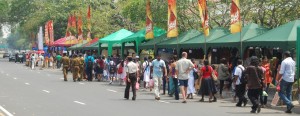Kala Pola: Carrying on the cultural legacy of George Keyt
The British art historian and critic, W.G. Archer’s classic book, “India and Modern Art” (1959 George Allen and Unwin Ltd, London), focused virtually exclusively on four outstanding painters, “to trace” what he called “the first modern movements in Indian art”.
Then, “Indian” meant South Asian. Three painters were Indians: Jamini Roy (assessed under the theme, Art and the Primitive); Amrita Sher-Gil (Art and the Village); and Rabindranath Tagore (Art and the Unconscious). The fourth was Sri Lanka’s George Keyt (Art and Romance).
Notwithstanding the rich, profound, centuries-old art traditions of the region, “modern” Indian paintings were then considered objects of elitist expression and appreciation and profitable acquisition. Today, contemporary, painting is no longer part of such exclusivist traditions. Its reach is extensive throughout South Asia.
In Sri Lanka, given the contemporary use of graphic art and pictorialisation for corporate purposes including advertising, media illustrations, interior décor and fashion-design, the annual Kala Pola has acquired wide-spread popularity and considerable corporate focus, utility and value. With generous support and sponsorship from corporate groups, particularly John Keells Holdings PLC, the George Keyt Foundation also performs a major cultural service for the public and particularly the artists. Talent in graphic art, design and painting is an increasing asset and livelihood skill for many artists.
The first Kala Pola, organised by the George Keyt Foundation with sponsorship and assistance from the John Keells Group, was held out-doors on Ananda Coomaraswamy Mawatha in 1993. Around 120 painters, mostly amateurs, were proud to hang their paintings for open public display, and thereafter: if they were in demand, for sale. Each year since then, the number of painters, amateur and professional, has increased. At the time of writing, the number of artists seeking display space at the January 2014 Kala Pola is around 350 and rising.
Initially, Keyt himself did not know what could be the true impact of the first Kala Pola. However, when Cedric and Sita de Silva, of the Foundation’s directorate, took Keyt through the milling enthusiastic crowds on Ananda Coomaraswamy Mawatha, he came to know its full cultural value and mass appeal and had joyously exclaimed : “Oh! I should have known!”
Distinguished personalities, including Ambassadors of diplomatic missions in Colombo have, over the years, gladly accepted invitations to open the Kala Pola. They have, for example, included US Ambassador Robert Blake, Indian High Commissioner Ashok Kantha, British High Commissioner John Rankin, French Ambassador Christine Robichon, and the Chinese Charge d’Affaires. Foreign diplomats and tourists seek paintings bearing a Sri Lankan flavour to take back home, as souvenirs, on their departure from the island. Many young artists are part of this lucrative supply chain.
The Kala Pola has helped young painters to benefit from the sale of their paintings. They have been inspired and encouraged to improve their work and develop their own personal styles and themes, mindful of the benefits they gain.
I first met George Keyt, then as husband of Ruth Keyt, my kindergarten teacher at Trinity College in Kandy. Keyt had earlier spent some introspective years at the Malwatte Temple in Kandy. By 1940, he had also completed painting the magnificent frescoes, depicting the Life of the Buddha at the Gotami Vihare in Borella, as a devotional exercise.
It was however, years later through Ian Goonetilake, the Librarian at Peradeniya University, that I came to know Keyt closely. Dr. Ashley Halpe, of the Department of English, worked tirelessly to edit and produce, the first well-illustrated Sri Lankan book devoted to Keyt, his art and poetry (George Keyt: A Felicitation Volume, Aitken Spence and Company, 1977). It was an exercise to which a wide spectrum of Keyt enthusiasts, contributed time and effort, including left-wing politicians Pieter Keuneman, Dr. Bernard Soysa and Hector Abhayawardhana as well as art critics Mulk Raj Anand and Martin Russell. I functioned as a politically non-aligned Secretary for the book, also contributing a chapter on “George Keyt and Sri Lankan Traditions”. The book greatly enhanced Keyt’s popularity in Sri Lanka, India and elsewhere, and his paintings came to be more widely sought thereafter. His works, given their value, have also been subject to forgeries, craftily produced by corrupt arty mercenaries, fooling particularly Sri Lanka’s diaspora overseas.
The George Keyt Foundation, thanks to continuing corporate sponsorship from John Keells and others, now strongly supports CCR (Corporate Cultural Responsibility), complementing CSR (Corporate Social Responsibility).
In addition to the Kala Pola, the Foundation has promoted another cultural initiative, the Nava Kala Karuwo exhibitions. While the Kala Pola is open to any amateur artist, the artists participating in the Nava Kala Karuwo are chosen on the basis of their proven artistic talents. Their works fetch higher prices. Many artists participating in these exhibitions earn at least some of their living from the sale of their works. Others also have acquired employment in various corporate entities requiring graphic talent and adaptability, particularly in public relations and the advertising sectors.
In December 2013, the George Keyt Foundation also organised the 2nd Sri Lankan Art Exhibition 2013 at the J.D.A. Perera Galleries on Horton Place, Colombo, with sponsorship by Nations Trust Bank and American Express. The works chosen for display were by experienced artists whose creativity had matured, many of them in professions and activities linked to their skills in art. Around 40 artists had their works exhibited.
The legacy of George Keyt thus endures with such endeavours !
The Kola Pola will be held on Sunday, January 26 from 8 a.m. to 10 p.m. at the boulevard from Nelum Pokuna


